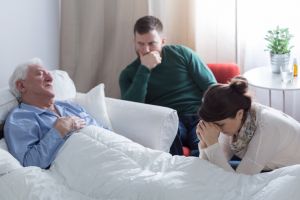 When a loved one dies in a hospital, most often the body is released to a funeral home for preparation for internment or cremation. In fact, a release form is necessary to have the body go anywhere but a funeral home. Some people, however, object to the immediate removal of the body from the care of the family. They harken back to pre-20th century customs that left the preparation of the body of loved ones to the women of the home. Proponents say the experience is more intimate and allows for a more profound grieving experience among friends and family.
When a loved one dies in a hospital, most often the body is released to a funeral home for preparation for internment or cremation. In fact, a release form is necessary to have the body go anywhere but a funeral home. Some people, however, object to the immediate removal of the body from the care of the family. They harken back to pre-20th century customs that left the preparation of the body of loved ones to the women of the home. Proponents say the experience is more intimate and allows for a more profound grieving experience among friends and family.
(Not So) Ancient History
Barely one hundred years ago, funeral preparation was the responsibility of the family. They were assisted by midwives and by women of the community who took up the work of caring for the body after death. A loved one may have taken up space in the parlor, laid across boards set over ice to help slow down decay. Caregivers would wash the body and wrap it in a shroud before burial. The body would stay out and visible so that people could pay their respects and to make certain the person was truly deceased.
The Good Death
In the Victorian era, Americans were much attached to the idea that the state in which a person died dictated the terms of their experience in the afterlife. It was therefore critical that the family monitor a person's death so that the soul could die in peace. Continued physical contact with the body strengthened the social bonds forged in life. A good death was had at home, surrounded by loved ones. Embalming was actually developed during the Civil War so that bodies could be returned home in as lifelike a condition as possible.
A Century of Change
Ironically, it was embalming that led to the funeral home replacing the family home as the primary place of mourning. Preparation of the body for burial became the domain of the men who performed the embalming procedure. As the 20th century progressed, more and more people lived in cities where space was at a premium few people had parlors in which to lay out their loved ones. In addition, the body began to be regarded as something unclean, best cared for by professionals.
Coming Home
Today the typical American funeral includes embalming, a viewing period and burial. There is a small population of people who are reconsidering the system. They are looking to take at least part of the process back into their own hands. One of these people is Elizabeth Knox. Some years back, Knox lost a child to a car accident and brought her daughter's body home from the hospital to care for it before cremation. Her nonprofit organization, Crossings, developed as a resource to help other people navigate the challenges and do the same. According to Crossings' philosophy, home care:
- Heals the living and helps alleviate the fear of death
- Honors those who have passed by caring for the vessel
- Serves the earth by limiting the use of toxic chemicals
The Search for Meaning and Connection
In the past decade or so, there has been a quiet shift in funeral customs. Although the majority of Americans may still balk at the idea of caring for their loved ones' bodies after death, they are changing prevalent funeral protocols in other ways. Some families order handmade unfinished pine caskets for mourners to decorate before burial. Others add a loved one's ashes to a coral reef, with a memorial service at sea. Still others honor a death by donating the body to medical research. At the heart of it all lies a yearning to find a way to connect with our loss so that we may say goodbye.
Add Your Comment